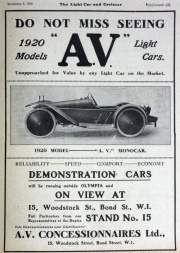Ward and Avey
Ward and Avey of Somerset Road, Teddington, Middlesex.
Founder (partners) were cousins George Leopold Holzapfel and Frederick Max Holzapfel. Ward and Avey were their respective mothers’s maiden names, that they took by Deed Poll during WWI.
1915-16 Built cars on behalf of Carden Engineering Co, see the 1917 Red Book.
Between 1919 and 1924, the company built the AV cyclecar. It was one of the more successful cyclecars; it was based on a design bought from Carden and built in the factory that he had previously used. At the peak they had 80 employees.
1919 Initially the cars were sold by A. V. Concessionaires Ltd.(see advert).
The first model was a single seater, the Monocar, only 30 inches wide with bodies built by the Thames Valley Pattern Works out of wood, plywood or even compressed paper. The complete car only weighed about 550 pounds. Engines were rear mounted, air-cooled and rated from 5 to 8 hp. There was a choice of JAP (most commonly), Blackburne or rarely MAG units. Gearboxes were either a two speed epicyclic unit with foot-operated change or three speed Sturmey-Archer with chain drive to the rear axle. Steering was by a wire and bobbin system with the entire front axle being pivoted on early cars. Several hundred were made.
1920 At the first Brooklands meeting of the Junior Car Club Reggie Empson entered with an AV.
In 1920 a two seater, the Bi-car, was added with the passenger behind the driver. The width of the car increased to 36 inches. About 50 were made. A more conventional side by side model was added in 1921 called the Runabout with a 42 inch body 126 inches long. The original Monocar and Bi-car were dropped in 1922 but production of the Runabout continued until 1924 and later to special order.
The company changed its name in 1923 to A. V. Motors Ltd. After the end of car production the firm became dealers for Jowett and later Rootes Group.
See Also
Sources of Information
- [1] Wikipedia



